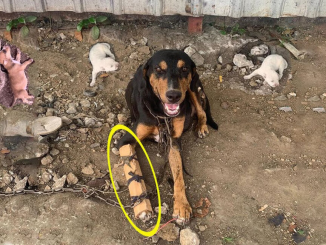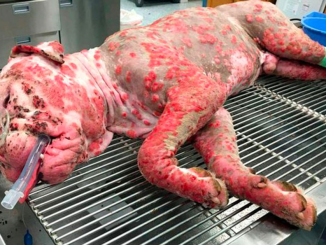Results indicated that not only can dogs detect Covid faster, but they can also do so in a non-intrusive manner – so no need to swab your throat or nose

Dogs can detect Covid-19 faster and more accurately than a PCR test, a new study shows.
Researchers looked at the ability of canines to recognise the virus and its variants, even when they are obscured by other viruses, like those from common colds and flu.
More than 400 scientists from over 30 countries contributed to the study as well as 147 scent dogs, according to the findings published in the Journal of Osteopathic Medicine.
After analysing many studies covering both field and clinical experiments, Professor Dickey and Junqueira found that dogs who are trained to sniff out scents are “as effective and often more effective” than antigen tests.
A total of 53 dogs were trained to sniff out Covid scents, while 37 were not and scientists found that the dogs that were not trained were in some cases “slightly superior” to those that were pre-trained.
“The previously untrained dogs have the advantage that they are not as prone to indicating on scents other than the Covid–19 associated scent,” the paper said.
The results indicated that not only can dogs detect Covid faster, but they can also do so in a non-intrusive manner. This means you won’t need to put a swab in your throat or nose.
How can dogs detect the virus?
This essentially comes down to the dog’s highly evolved nose with its ability to sense out smells quicker.
Dogs possess up to 300 million olfactory receptors in their noses, compared to about six million in humans. And the part of a dog’s brain that is devoted to analysing smells is about “40 times greater” than humans. Canines also have ‘neophilia’, which means they are attracted to new and interesting odours
And so, with all these enhancements, dogs can detect very low concentrations of odours associated with Covid infections.
“They can detect the equivalent of one drop of an odorous substance in 10.5 Olympic-sized swimming pools,” Professor Dickey said. “For perspective, this is about three orders of magnitude better than with scientific instrumentation.”
Scientists also found that in some cases, the animals were also able to detect the virus in pre-symptomatic and asymptomatic patients, “whose viral load was too low for conventional tests to work.”
Professor Dickey has said that dogs can also differentiate Covid and its different variants in the presence of other respiratory viruses. This included the common cold or flu.
“They’re much more effective. In fact, one of the authors that we quote in the paper commented that the RT-PCR test is not the gold standard anymore. It’s the dog. And they’re so quick,” he added. “They can give you the yes or no within seconds if they’re directly smelling you.”

How was the study conducted to see if dogs can really detect Covid-19?
In some studies, the dogs gave a person a quick sniff, sitting down to see if the person has Covid. In another study, the dog was given a sweat sample to smell for a few minutes.
The press release has said that scent dogs, such as beagles, basset hounds and coonhounds are the ideal candidates for sniffing out the virus, given their “natural tendencies to rely on odours to relate to the world.”
But the studies which the researchers analysed showed a variety of dogs were up for the challenge and were able to sniff out the Covid odour. With a few weeks of training, puppies, older dogs, purebred and mixed breeds, both male and female were able to sniff such odours out and “all performed admirably,” the Eureka Alert press release said.
Although there has been success with dogs detecting such viruses, researchers believe there are still many challenges with using dogs for medical diagnoses.
“There’s quite a bit of research, but it’s still considered by many as a kind of a curiosity,” said Professor Dickey.
In conclusion, Professor Dickey and Junqueira said after reviewing the studies, believe that scent dogs deserve “their place as a serious diagnostic methodology that could be particularly useful during future pandemics, potentially as part of rapid routine health screenings in public spaces.”
“Perhaps, most importantly, we argue that the impressive international quality and quantity of COVID scent dog research described in our paper for the first time, demonstrates that medical scent dogs are finally ready for a host of mainstream medical applications,” they added.
Abandoned And Trapped In Deep River, The Elderly Dog started crying When The Volunteer Approached To Caress Him
In the heart of Los Angeles, a tale unfolded that touched the souls of many—a tale of abandonment, resilience, and compassion. It began with a simple phone call, one that sparked a mission of hope and redemption for a lonely soul trapped in the depths of the city’s river.

The call came to Hope in the Paws, a beacon of light for animals in distress. On the other end of the line was a plea for help, a desperate cry for assistance for an elderly dog stranded in the labyrinthine maze of the Los Angeles River. For weeks, the community had rallied around the dog, providing what little sustenance they could offer, but they knew that without intervention, his fate would be sealed.

With urgency in their hearts and determination in their eyes, the volunteers of Hope in the Paws sprang into action. But as they approached the river’s edge, they were met with a sight that tugged at their heartstrings—the elderly dog, once proud and majestic, now reduced to a trembling, frightened creature, his eyes betraying the fear and uncertainty that gripped his soul.

Undeterred by the enormity of the task before them, the volunteers pressed on, fueled by a singular purpose—to bring comfort and salvation to this vulnerable being. With each step closer, they could hear the soft whimpering of the dog, a haunting melody that echoed through the silence of the river.

But then, something miraculous happened. As one of the volunteers extended a hand of kindness towards the dog, offering nothing but love and compassion, the trembling ceased, and the fear began to ebb away. In that moment, amidst the chaos and turmoil of the river, a bond was formed—a bond forged in the crucible of adversity and sealed with the simple yet profound language of empathy.

With gentle hands and tender words, the volunteers lifted the elderly dog from his watery prison, cradling him in their arms as they made their way to safety. And as they emerged from the depths of the river, they were greeted by the warm embrace of the community, their faces alight with gratitude and hope.
The rescue of Peggy the German Shepherd was not just a triumph of human kindness—it was a testament to the power of compassion and the resilience of the human spirit. And as Peggy took her first tentative steps towards a new life, she carried with her the unwavering support of all those who had rallied behind her—a reminder that no soul is ever truly alone as long as there are hearts willing to open and hands ready to help.
So here’s to Hope in the Paws, an organization built on the belief that every life is worth saving and every creature deserving of love. Thank you for your tireless dedication, your boundless compassion, and your unwavering commitment to making the world a better place—one rescue at a time.
And to Peggy, may your journey be filled with warmth and joy, and may you always know that you are loved beyond measure. You may have been abandoned and trapped in the depths of a river, but today, you are free—free to run, free to play, and free to bask in the boundless love that surrounds you.
This is the story of Peggy the German Shepherd—a story of hope, redemption, and the enduring power of love. And as her tale spreads far and wide, may it serve as a beacon of hope for all those who find themselves lost and alone in the world.



Leave a Reply